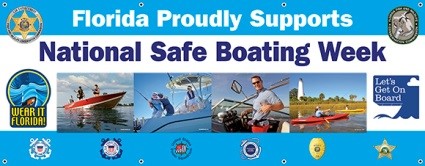
2016 SUMMARY OF BOATING ACCIDENTS
- Florida leads the nation with a total number of 931,450 registered vessels in 2016.
- There was a total of 714 reportable boating accidents in 2016.
- Collison with vessel was the leading type of accident with a total of 181 (25%).
- Towed watersport activities were involved in 13 accidents, resulting in 13 injuries.
- Paddlecraft (canoes, kayaks, rowboats, paddleboards) were involved in 10 accidents resulting in nine fatalities and three injuries.
- July was the month with the highest number of accidents (96).
- Monroe County reported the highest number of accidents and injuries (105 total accidents with three fatalities and 52 injuries).
BOATING FATALITIES
- 56 fatal accidents for 2016 resulting in 67 fatalities.
- 29% of the fatal accidents were falls overboard (16 accidents). Boaters falling overboard remains the main cause of boating fatalities.
- The leading cause of death in fatal boating accidents was drowning with 40 fatalities (60%).
- July was the deadliest month in 2016 with eight fatalities.
- Alcohol or drug use is reported to have played a role in 24% boating fatalities.
- 95% (58) of the victims of fatal boating accidents were males.
- 65% (39) of the 60 operators involved in fatal accidents were age 36 or older.
- 78% (47) of all vessels involved in fatal accidents in 2016 were 21 feet in length or less.
BOATING INJURIES
- There were 714 accidents resulting in 421 injuries. The rate of injury was 45 injuries per 100,000 registered vessels.
- REPORTABLE PERSONAL WATERCRAFT ACCIDENTS
- Personal watercraft (PWC) accounted for 13% of all registered vessels in Florida.
- PWCs were involved in 26% (253) of reportable boating accidents.
- Rented PWCs represented 41% (89) of PWC involved in accidents
- 42% of PWC accidents involved a collision with another vessel.
- 45% of PWC accidents occurred in Miami-Dade (32), Monroe (20), and Pinellas (18) counties.
- 11 fatalities resulted from the 158 PWC accidents.
EDUCATION STATISTICS
- The Florida Fish & Wildlife Coservation Commission (FWC) issued 47,307 Boating Safety Education ID Cards in 2016.
- 63% of the cards were issued to persons born on or after January 1, 1988.
- Of the 47,307 cards issued, 34,654 were issued to males, 12,606 were issued to females. An additional 1,132 cards were printed for lost, damaged, and information changes.
- 70% of the operators involved in fatal accidents had no formal boater education.
Boating education is critical
Florida’s current boating safety education law only applies to boaters born on or after January 1, 1988, operating a motorized vessel of 10 horsepower or greater. The face-to-face contacts by FWC officers and its partner agencies are a critical part of outreach efforts and education to the boating public. These statistics show us that the boat operator most likely to be involved in a boating accident is a middle-aged or older male who has boating experience, yet has never learned the most important safety considerations by having taken a boating safety course. When officers observe boating violations or perform fresh and saltwater resource enforcement activities, they conduct boating safety inspections aimed at both identifying and preventing violations or accidents. FWC officers make boating safer and ultimately save lives.
Safe boating is a choice
Florida is the leader in promoting boating accident prevention. The FWC, in association with the National Safe Boating Council, Bombardier Recreational Products Inc., West Marine, and the U.S. Coast Guard (USCG), launched a statewide boating safety campaign as part of a national initiative. The “Wear It Florida” campaign encourages boaters to wear life jackets anytime they are on the water and educates boaters about the ease and convenience of inflatable life jackets. The campaign is designed to reach the public through a variety of methods including media events, exhibits, personal contacts, social media, radio, and televised public service announcements.
For more information, contact Samuel Cohen of Hicks & Motto at scohen@hmelawfirm.com or phone 561.683.2300.
